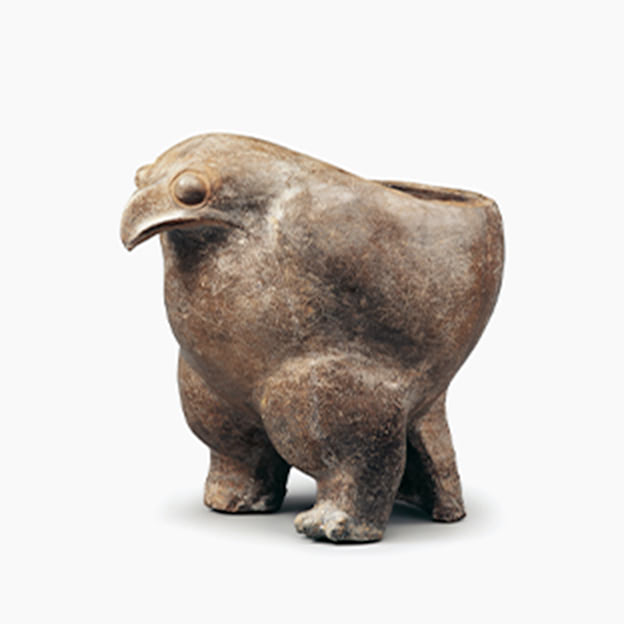
-
Eagle-shaped Pottery Tripod
Neolithic, Yangshao culture(c. 5000–3000 BCE)
Height 35.8 cm, diameter of mouth 23.3 cm
This potterytripod is modeled like a standing eagle. The eagle has rounded eyes, hooked beak and a strong body supported by sturdy legs. In a simple structure, the whole vessel looks powerful and majestic.The beauty of the eagle is subtly blended with the function of this utensil. It is a perfect combination of primitive art and practical function and a rare treasure of ancient sculpture.
The Yangshao culture is known for finelypainted pottery. This eagle-shaped pottery tripod shows that people then were not only good at creating painted patterns, but also had great mastery of plastic arts.
In 1993, China made its first bid to host the Olympics, which coincided with the completion of the new Olympic Museum in Lausanne. Thispottery tripod was among the nine national treasures selected by the Chinese Olympic Committee to be on display in an exhibition in Lausanne. It had impressed the visitors for the combination of both simplicity of Neolithic style and modern artistry.
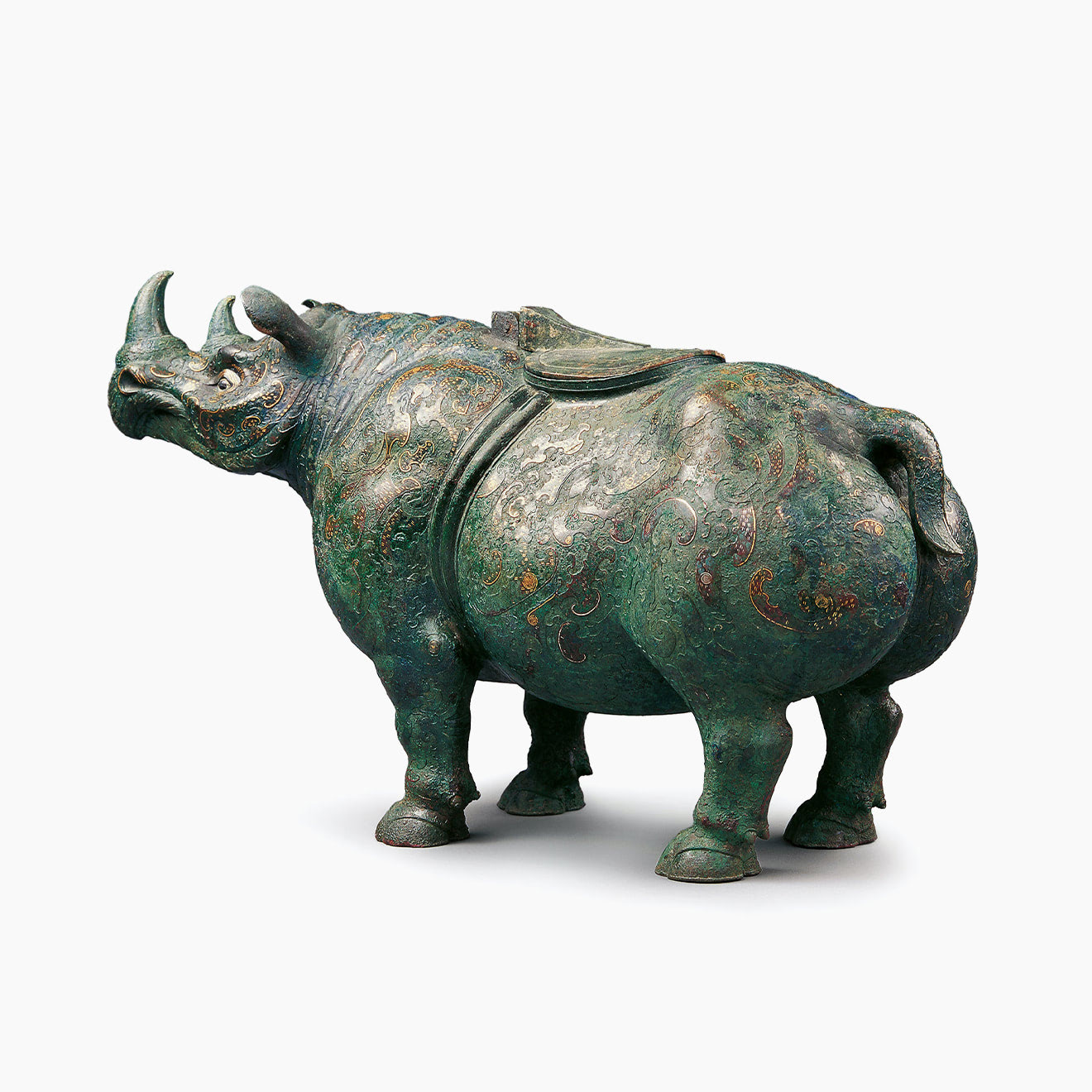
-
Rhinoceros-shaped Bronze Wine Vessel (zun) Inlaid with Gold and Silver Cloud Design
Western Han dynasty(202 BCE–8 CE)
Height 34.1 cm, length 58.1 cm, weight 13.3 kg
Zun is an ancient Chinese bronze wine vessel. This Zun is in the shape of a rhinoceros, with raised head, plump body, and eyes inlaid with black beads. Its body is hollow for holding wine. There is an oval-shapedopening on the rhinoceros’ back with a lid. To the right of the rhinoceros’ mouth, there is a round tube, a tubular spout to pour wine. The whole body is decorated with inlaid gold and silver cloud patterns, shining brightly and extremely gorgeous. Its shape is based on a typical Sumatran rhinoceros that lived in ancient China. In ancient times, China was home to a large number of rhinoceroses. When making this vessel, ancient artisans creatively adopted the inlaid gold and silver techniques that were popular during the Spring and Autumn and the Warring States periods, infusing the object with a vibrant sense of fun and freedom.
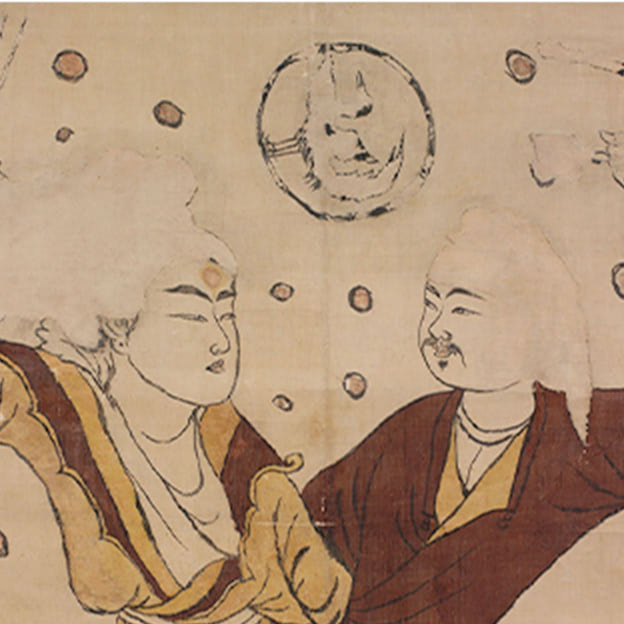
-
Painting of Fuxi and Nuwa
Tang dynasty (618–907)
144.3×101.7 cm
For more than 800 years from the Han dynasty to the Tang dynasty, the Turpan region was predominantly inhabited by the Han people, who lived together with people from other countries and ethnic groups. While the Central Plains Chinese culture was well preserved here, exotic cultures were integrated with the local culture.
The ancient belief of Fuxi and Nuwa was spread through silk paintings and they were worshiped by multiple ethnic groups. The story of Fuxi and Nuwa is very similar to the Christian story of Adam and Eve. These two groups of mythological figures reflect different cultures and philosophies.Fuxi and Nuwa were the first mythical ancestors of the Chinese. In this painting, Fuxi and Nuwa are depicted between the sun (top) and the moon (bottom). In traditional Chinese culture, the sun and moon represent yang and yin respectively, which are the two basic material components of the world.
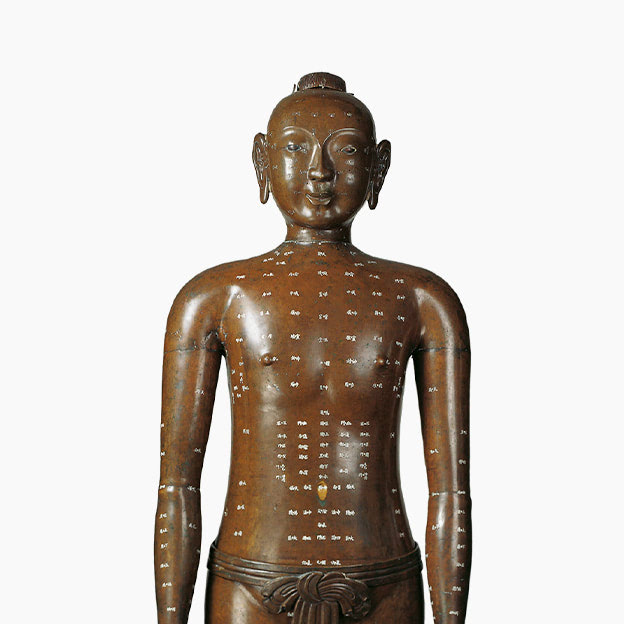
-
Bronze Figure Model for Acupuncture and Moxibustion
Ming dynasty (1368–1644)
Height 213 cm
Bronze figure model for acupuncture and moxibustion is an important invention in the history of human education and a valuabletool in the teaching of acupuncture and moxibustion. On 18 January 2017, Chinese President Xi Jinping visited the World Health Organization in Geneva, Switzerland and presented a bronze figure sculpturefor acupuncture and moxibustion, which was designed and made based on this Ming dynastymodel. President Xi described this sculpture as a replica of the first model used in medical teaching and training and spoke highly of it.
The study of acupuncture and moxibustionis an important part of Traditional Chinese Medicine, which includes the theory of acupuncture and moxibustion, meridians, acupoints, acupuncture and moxibustion techniques. It is valuable cultural heritage developed on Chinese scientific traditions and has spread around the world.
The creation of this bronze figure model for acupuncture and moxibustion reflects the high level of aesthetics and casting technology of the time. It was cast in 1443, in the eighth year of theZhengtong period of the Ming dynasty under the order of Emperor Yingzong, as a reproduction of a previous model. There had been other bronze figures of this kind made during the Ming and Qing dynasties.
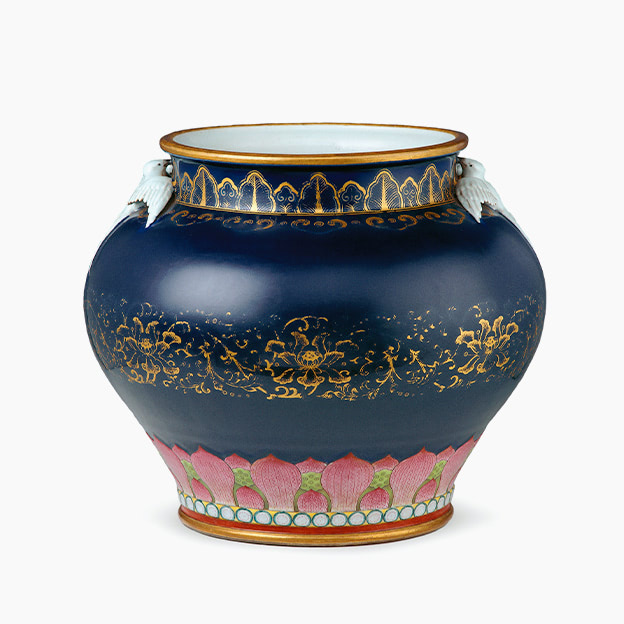
-
Porcelain Jar with Swallows and Gold-painted Design
Qing dynasty, Qianlong period(1736–1795)
Height 31.3 cm, diameter of mouth 25.1 cm, diameter of bottom 22.7 cm
This jar was made in the imperial kilns of Jingdezhen for the Haiyan Hall in Yuanmingyuan (part of the Old Summer Palace in Beijing). The jar has a flared mouth, short neck, and swelling body and is tapered towards the base. A pair of white glazed swallows rest on the shoulder, forming the jar’s two lugs. The vessel’s body is covered with blue glaze, decorated with plantain leaves,intertwining branches,and flowers painted in gold, and lotus motifs and pearl roundels near the foot. Re-firing and re-painting several times was required in the making of this jar, and the production involved carving, appliqué, and pressing.
In the Chinese language, “swallow” and “calm seas” are homophones, and the same is to “lotus” and “rivers”. The blue glaze symbolizes calmness and clarity and the whole jar symbolizes a stable environment for lasting peace. During the Qianlong period, the production technology of famille rose porcelain reached its peak, with a complete range of varieties, rich and varied decorative techniques, superb painting skills, and exquisite styles.
